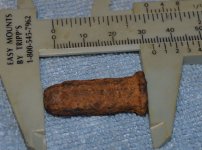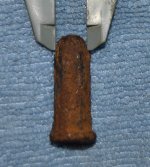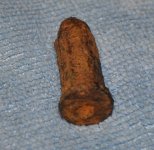EastTexasChris
Inactive
New to the Forum here, so thanks for any help. While at a group outing around Vein Mt, North Carolina, I found an odd shaped complete cartridge while preparing for a MD hunt. It is pretty badly corroded, but it is obvious that the cartridge is hexagonal(six flat sides) shaped. The base is round and has a primer, is not necked down(like most rifle cartridges), and has a round nose lead bullet. From the corrosion, it appears that the cartridge could be made of steel. Its dimensions are: case length=27 mm, total length=33 mm, bullet diameter=10mm. No one at the MD hunt had seen anything like it and so far my internet search(pretty extensive) has not turned up any references to hexagonal cartridges, only barrels or internal rifling. The corrosion prevents seeing any stamping on the end of the cartridge. I have brushed the sand/dirt from it, but hesitate to do any further cleaning for fear of damaging it. Thanks for any comments.



